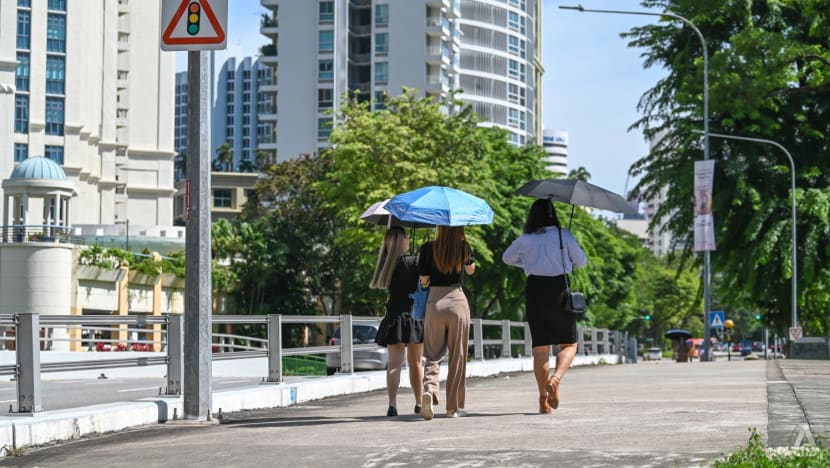Concerns grow over heat-related health risks as Singapore gets warmer
Researchers are studying the potential threat to health in a hotter climate, and developing strategies to mitigate the adverse effects of higher temperatures.


This audio is generated by an AI tool.
SINGAPORE: With Singapore projected to get warmer in the next few decades, concern is growing about the increased risks of heat-related illnesses and chronic conditions.
Researchers are studying the potential threat to health in a hotter climate, and developing strategies to mitigate the adverse effects of higher temperatures.
At the National University Singapore’s (NUS) Yong Loo Lin School of Medicine, a climatic chamber allows researchers to understand individuals’ responses to heat stress.
The facility can simulate various environmental conditions, including what a regular day outdoors could feel like by mid-century – a blistering 40 degrees Celsius and 40 per cent humidity.

It then measures the subjects’ metabolic, cardiovascular and thermoregulatory responses to heat stress as they undergo physiological testing.
“Usually, we undertake experiments here via passively heating our individuals,” said Associate Professor Jason Lee, director of the school’s Heat Resilience and Performance Centre.
“We look at cognitive performance and learning ability. We (also) exert individuals while they are performing a task and look at their limits in various conditions.”
His field of study examines various methods and solutions to ensure that humans can thrive in evolving environments, including warming temperatures.
“All of us will one way or the other be negatively affected by rising heat. Humans can feel more fatigued. Heat can compromise work productivity, exacerbate existing health conditions and worsen mental health conditions,” Prof Lee said.
“From an epidemiological perspective, associations with heat stress are there … I expect (as the temperature increases, it) could induce a significant load on our already overloaded healthcare system.”
HEAT-RELATED CASES SPIKE IN HOTTER MONTHS
The National University Health System (NUHS) said there is a correlation between the number of heat-related illnesses and the weather.
Heat exhaustion cases tend to peak in the hotter months of the year, and decrease towards December, when the weather is cooler.
Dr Benjamin Leong, an emergency medicine department senior consultant at the National University Hospital (NUH), said that while heat exhaustion accounts for a very small number of patients he sees, there may be more cases that go unnoticed.
“By the time they (patients) come to the emergency department, it tends to be a more serious form of heat illness, but that's only the tip of the iceberg,” he said.
“Probably a majority of them might present as fatigue or vague symptoms like tiredness or lethargy, for which they may not come to the emergency department. So we won't see the true burden of the number of cases that are experienced in the community.”
HEAT CAN WORSEN SKIN CONDITIONS
Hotter weather can also make things worse for patients with chronic skin problems.
Dr Vanessa Lim, a consultant at the National Skin Centre, said conditions such as eczema or urticaria – known commonly as hives – can be induced or made worse by higher temperatures.
“During the hot season, sweat tends to get trapped in body parts like the inner side of the elbows, the back of the knees and the area around the neck,” she said. “These areas may present with more rashes that can be very itchy and disturbing to the quality of sleep or even day-to-day quality of life.”
Medical professionals said more vulnerable groups such as infants and the elderly are at higher risk of heat-related illnesses.
People who work outdoors and are unable to seek shelter during their working hours, including platform workers or those in the construction sector, as well as those who work indoors in warm environments such as factories, are also at greater risk.
WARMER WEATHER AHEAD
The recent national climate study by the Centre for Climate Research Singapore (CCRS) showed that if the world fails to rein in global warming, Singapore could heat up by as much as 5 degrees Celsius by the year 2100.
The study released last Friday (Jan 5) said Singapore could face very hot days ahead, with daily maximum temperatures exceeding 35 degrees Celsius for up to 351 days in a year.
Studies have suggested that excessive heat could be linked to higher instances of heart attacks and multiple sclerosis, and lower fertility rates.
More common conditions such as dehydration and heat stroke are also set to occur more frequently when the mercury rises.
STRATEGIES TO KEEP COOL
The answer to reducing the impact of rising heat on public health may lie in how well the built environment and the population can adapt, said Professor Wong Nyuk Hien, of the NUS College of Design and Engineering’s Department of the Built Environment.
A team at NUS has been working with the Housing and Development Board (HDB), schools and hospitals on strategies to keep buildings cool, such as using cooling paint, natural ventilation and introducing greenery on walls and roofs. Providing shade outdoors to offer respite from the heat is important as well.
However, people also need to acclimatise to the warmer weather and rely less on air conditioning, experts said.
“We do not want to encourage people to just turn on the air conditioning when they feel warm,” Prof Wong noted.
“When you turn on the aircon, the aircon dumps the heat outside, and that will result in (warmer temperatures outside, leading to even) more usage of aircon. It’s a vicious circle and we need to minimise that from happening.
“We must make our cooling sustainable. For example, using mixed-mode ventilation such as using an aircon together with a fan. This can increase the setpoint temperature and reduce the energy consumption for cooling.”






















